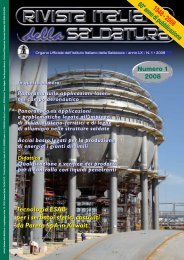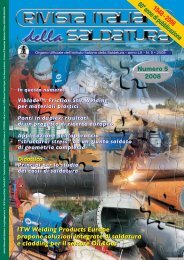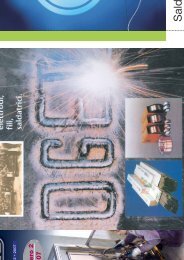Create successful ePaper yourself
Turn your PDF publications into a flip-book with our unique Google optimized e-Paper software.
E. Seib e M. Koçak - Fracture analysis of strength undermatched welds of thin-walled aluminium structures using FITNET procedure<br />
The FITNET FFS approach uses the<br />
methodology formerly known as the<br />
SINTAP procedure [8] and extends it<br />
with fully validated strength undermatched<br />
welded thin-walled structures.<br />
If the yield strength difference between<br />
the base and weld materials is more than<br />
10%, the FITNETT FFS Mismatch<br />
Option provides an assessment route<br />
accounting for the special features of<br />
welds, as it was established within the<br />
SINTAP procedure.<br />
In the following, only the set of equations<br />
for the Mismatch Option of the<br />
Fracture Module will be given. For the<br />
complete information on the different<br />
analysis options within the FITNET FFS<br />
Procedure, the reader is referred to [3].<br />
The required input information, as<br />
schematically illustrated in Figure 7, for<br />
the application of the Fracture Module<br />
to cracked welded structures will be<br />
given subsequently, including the determination<br />
of the weld metal tensile and<br />
fracture properties.<br />
4.1 FITNET FFS Procedure - Fracture<br />
Module: Option 2: Weld strength<br />
mismatch<br />
The Fracture Module provides two<br />
Material related input:<br />
- tensile properties<br />
of base and weld materials<br />
- fracture resistance<br />
complementary analysis routes: Failure<br />
Assessment Diagram (FAD) and Crack<br />
Driving Force (CDF). Since both routes<br />
are based on the same set of equations,<br />
their predictions are also the same.<br />
Therefore, only the CDF route will be<br />
presented in this paper. The CDF<br />
expression in terms of the crack tip<br />
opening displacement (CTOD), δ, is<br />
given as:<br />
with the elastic part of CTOD, δ e:<br />
K denotes the elastic stress intensity<br />
factor,<br />
the parameter m (m = 1 for plane stress<br />
and m = 2 for plane strain) is considered<br />
a constraint parameter,<br />
E’ = E for place stress and<br />
E’ = E/(1-v 2 ) for plane strain (E =<br />
Young’s modulus, v = Poisson’s ration),<br />
and<br />
FITNET Procedure<br />
Fracture Module<br />
Prediction of critical conditions:<br />
- critical crack size<br />
- maximum load level<br />
Figure 7 - Required input information for the application of the FITNET FFS Procedure - Fracture Module.<br />
(5)<br />
(6)<br />
is the ratio of externally applied load, F,<br />
and the yield load, F Y, of the cracked<br />
component which is a function of the<br />
material’s yield strength, σ Y, of the<br />
crack location and component/weld<br />
geometry. Regarding the selection of E’,<br />
the plane stress condition has been<br />
chosen due to the fact of the thin sheet<br />
material. It should be pointed out that<br />
for v = 0.3, E’ for the plane strain case<br />
differs only by a factor of 1.1<br />
from the plane stress case, whereas the<br />
variation of m between 1 and 2 is much<br />
more pronounced. The plasticity correction<br />
function, ƒ/(L r) is subdivided into<br />
different options within the FITNET<br />
FFS Procedure and is dependent on the<br />
extent of the material data input and on<br />
the case analyzed (homogeneous or<br />
heterogeneous with strength mismatch).<br />
For a strength mismatched configuration<br />
(FITNET FFS Fracture Module Option<br />
2), the plasticity correction function is<br />
defined as:<br />
Component or structure<br />
related input:<br />
- K-factor solution<br />
- Yield load solution<br />
(7)<br />
Riv. Ital. Saldatura - n. 1 - Gennaio / Febbraio <strong>2007</strong><br />
95





